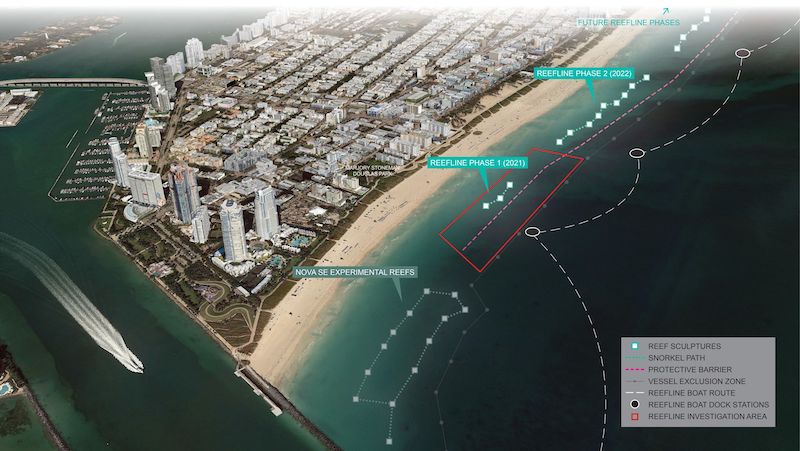The ReefLine will be a new seven-mile-long underwater public sculpture park, snorkel trail, and artificial reef located off Miami Beach’s shoreline. OMA is collaborating with a team of marine biologists, researchers, architects, and costal engineers to design the project’s master plan and a distinct sculpture within it.
OMA has designed a geometric, concrete modular unit that can be deployed and stacked from South Beach to the north, following the topography of the sea bed. The living breakwater is the connective tissue for the overall master plan and will be punctuated by a series of site-specific installations.

The project will be completed in phases. The first mile is slated to open in December 2021 with permanent installations by Argentine conceptual artist Leandro Erlich and Shohei Shigematsu of OMA. Erlich will create Concrete Coral, an installation that will reframe cars and trucks as new vehicles for environmental change.

OMA/Shigematsu’s sculpture explores the nature of weightlessness underwater. A series of sinuous spiral stairs creates a three-dimensional structure reminiscent of marine life. The organic form provides layered zones for coral reef growth and interstitial spaces for exploration. The stairs rotate around a central forum for underwater gathering and activities.
In addition to the artistic qualities, The ReefLine will also provide a critical habitat for endangered reef organisms, promoting biodiversity and enhancing coastal resilience.


Related Stories
| Aug 10, 2022
U.S. needs more than four million new apartments by 2035
Roughly 4.3 million new apartments will be necessary by 2035 to meet rising demand, according to research from the National Multifamily Housing Council (NMHC) and National Apartment Association.
| Aug 10, 2022
Gresham Smith Founder, Batey M. Gresham Jr., passes at Age 88
It is with deep sadness that Gresham Smith announces the passing of Batey M. Gresham Jr., AIA—one of the firm’s founders.
| Aug 9, 2022
Work-from-home trend could result in $500 billion of lost value in office real estate
Researchers find major changes in lease revenues, office occupancy, lease renewal rates.
| Aug 9, 2022
5 Lean principles of design-build
Simply put, lean is the practice of creating more value with fewer resources.
| Aug 9, 2022
Designing healthy learning environments
Studies confirm healthy environments can improve learning outcomes and student success.
Legislation | Aug 8, 2022
Inflation Reduction Act includes over $5 billion for low carbon procurement
The Inflation Reduction Act of 2022, recently passed by the U.S. Senate, sets aside over $5 billion for low carbon procurement in the built environment.
| Aug 8, 2022
Mass timber and net zero design for higher education and lab buildings
When sourced from sustainably managed forests, the use of wood as a replacement for concrete and steel on larger scale construction projects has myriad economic and environmental benefits that have been thoroughly outlined in everything from academic journals to the pages of Newsweek.
AEC Tech | Aug 8, 2022
The technology balancing act
As our world reopens from COVID isolation, we are entering back into undefined territory – a form of hybrid existence.
Legislation | Aug 5, 2022
D.C. City Council moves to require net-zero construction by 2026
The Washington, D.C. City Council unanimously passed legislation that would require all new buildings and substantial renovations in D.C. to be net-zero construction by 2026.
Cultural Facilities | Aug 5, 2022
A time and a place: Telling American stories through architecture
As the United States enters the year 2026, it will commence celebrating a cycle of Sestercentennials, or 250th anniversaries, of historic and cultural events across the land.

















